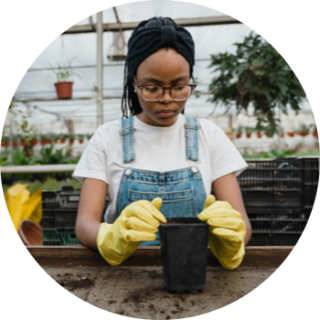Growing the field for Tree Equity
Over the past five years, American Forests has led and mobilized a nationwide movement of frontline advocates, national partners and allies to address the inequity around tree cover in American cities by income and race, and its life-or-death implications. Our own Tree Equity Score highlights this disparity: that communities of color tend to have 45% less tree cover than white communities, and lower income communities have 36% less than wealthier ones, leading to these neighborhoods being 6-9°F hotter as well. With extreme heat and flooding increasingly ravaging these communities, Tree Equity is a true climate justice issue. However, many cities and towns, and community-based organizations lack the needed funds, resources or bandwidth to achieve Tree Equity in their communities.
American Forests both unlocked $1.5 billion through our policy efforts in the Inflation Reduction Act of 2022 (IRA) and secured $50m of this public funding to deploy to the highest-need communities. Over the next five years through the Catalyst Initiative, American Forests will work to remove barriers for organizations and municipalities who can move the needle for Tree Equity on the ground by providing critical learning opportunities, technical assistance and funding. The Catalyst Initiative will undertake the following:
- Identifying and engaging city, community frontline and faith-based actors facing the greatest barriers to entry into the Tree Equity movement.
- Provide no-cost technical assistance with American Forests’ Tree Equity tools and expertise.
- Through the Catalyst Fund, provide cash grants which, when paired with tailored technical assistance, can realize catalytic and sustained progress in Tree Equity for those actors facing barriers to entry.
Working in close partnership with the U.S. Forest Service, American Forests will launch a first round of support through the Catalyst Fund for small and large cities beginning in early 2024.
The Catalyst Initiative and Catalyst Fund are a key part of our promise to help at least 100 cities make meaningful progress on Tree Equity by 2030 through best-in-class tools, resources and equitable funding. If you want more information about future opportunities to partner or be involved, please email info@americanforests.org.
Webinar Recordings
Communities of color and lower income communities have 36-45% less tree cover and are 6-9°F hotter than wealthier and whiter communities. Tree Equity is a climate justice issue. This series is geared toward recipients of the USDA-Forest Service 2023 Urban and Community Forestry grant awards, an unprecedented national $1.5B investment in urban and community forestry, but open to all involved in urban and community forestry. Watch our free online learning series to ensure your urban forestry investments make an impact on Tree Equity.
#1 Tree Equity in Action
January 11, 2024 at 2pm Eastern / 11am Pacific
In our first webinar on January 11, Digging into Tree Equity Score, American Forests’ experts in urban forestry, data, mapping and GIS, and community engagement outlined the Tree Equity Score tool and introduce its applications in communities for implementing tree equity.
#2 Equitable Planning and Planting
February 29, 2024 at 2pm Eastern / 11am Pacific
In our second webinar on February 29, Equitable Planning & Planting, our local partners at Keep Indianapolis Beautiful will share how they are catalyzing Tree Equity through local action and deep community engagement. American Forests experts in urban forestry and community engagement will share tools and resources to support action in your city, including the Community Action Guide – build a community-driven process to advance Tree Equity.
#3 Growing Careers
March 28, 2024 at 2pm Eastern / 11am Pacific
In our third webinar on March 28, Growing Careers, we will dive into the economic equity imperative of growing careers and workforce opportunities in urban forestry. Our local partners at The Works, Inc in Memphis, TN will share how they are tapping into Tree Equity careers for their community from nurseries to planting to urban wood reuse through launching a successful workforce development program in 2023. American Forests experts in workforce development will share tools and resources to support your planning for an equitable workforce in urban forestry – across the supply chain.
#4 Faith in Tree Equity
April 25, 2024 at 2pm Eastern / 11am Pacific
In our fourth webinar ‘Faith in Tree Equity’ on April 25th – during Earth Week and Faith in Climate Action Week – we will dive into the role that faith communities play in advancing action on Tree Equity, what successful partnerships with faith communities look like, and tools to support organizing on Tree Equity action for faith organizations.



